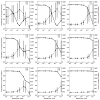The effect of population bottlenecks on mutation rate evolution in asexual populations
- PMID: 24330404
- PMCID: PMC4059786
- DOI: 10.1111/jeb.12284
The effect of population bottlenecks on mutation rate evolution in asexual populations
Abstract
In the absence of recombination, a mutator allele can spread through a population by hitchhiking with beneficial mutations that appear in its genetic background. Theoretical studies over the past decade have shown that the survival and fixation probability of beneficial mutations can be severely reduced by population size bottlenecks. Here, we use computational modelling and evolution experiments with the yeast S. cerevisiae to examine whether population bottlenecks can affect mutator dynamics in adapting asexual populations. In simulation, we show that population bottlenecks can inhibit mutator hitchhiking with beneficial mutations and are most effective at lower beneficial mutation supply rates. We then subjected experimental populations of yeast propagated at the same effective population size to three different bottleneck regimes and observed that the speed of mutator hitchhiking was significantly slower at smaller bottlenecks, consistent with our theoretical expectations. Our results, thus, suggest that bottlenecks can be an important factor in mutation rate evolution and can in certain circumstances act to stabilize or, at least, delay the progressive elevation of mutation rates in asexual populations. Additionally, our findings provide the first experimental support for the theoretically postulated effect of population bottlenecks on beneficial mutations and demonstrate the usefulness of studying mutator frequency dynamics for understanding the underlying dynamics of fitness-affecting mutations.
Keywords: asexual populations; beneficial mutations; hitchhiking; mutation rate; population bottlenecks; yeast.
© 2013 The Authors. Journal of Evolutionary Biology © 2013 European Society For Evolutionary Biology.
Figures




Similar articles
-
Contrasting dynamics of a mutator allele in asexual populations of differing size.Evolution. 2012 Jul;66(7):2329-34. doi: 10.1111/j.1558-5646.2011.01577.x. Epub 2012 Mar 4. Evolution. 2012. PMID: 22759305 Free PMC article.
-
Evolution of Mutation Rates in Rapidly Adapting Asexual Populations.Genetics. 2016 Nov;204(3):1249-1266. doi: 10.1534/genetics.116.193565. Epub 2016 Sep 19. Genetics. 2016. PMID: 27646140 Free PMC article.
-
Mutator dynamics in sexual and asexual experimental populations of yeast.BMC Evol Biol. 2011 Jun 7;11:158. doi: 10.1186/1471-2148-11-158. BMC Evol Biol. 2011. PMID: 21649918 Free PMC article.
-
Experimental evolution and the dynamics of genomic mutation rate modifiers.Heredity (Edinb). 2014 Nov;113(5):375-80. doi: 10.1038/hdy.2014.49. Epub 2014 May 21. Heredity (Edinb). 2014. PMID: 24849169 Free PMC article. Review.
-
Beneficial mutations and the dynamics of adaptation in asexual populations.Philos Trans R Soc Lond B Biol Sci. 2010 Apr 27;365(1544):1255-63. doi: 10.1098/rstb.2009.0290. Philos Trans R Soc Lond B Biol Sci. 2010. PMID: 20308101 Free PMC article. Review.
Cited by
-
Synonymous rpsH variants: the common denominator in Escherichia coli adapting to ionizing radiation.NAR Genom Bioinform. 2024 Aug 24;6(3):lqae110. doi: 10.1093/nargab/lqae110. eCollection 2024 Sep. NAR Genom Bioinform. 2024. PMID: 39184377 Free PMC article.
-
Selecting for infectivity across metapopulations can increase virulence in the social microbe Bacillus thuringiensis.Evol Appl. 2023 Jan 16;16(3):705-720. doi: 10.1111/eva.13529. eCollection 2023 Mar. Evol Appl. 2023. PMID: 36969139 Free PMC article.
-
Sign of selection on mutation rate modifiers depends on population size.Proc Natl Acad Sci U S A. 2018 Mar 27;115(13):3422-3427. doi: 10.1073/pnas.1715996115. Epub 2018 Mar 12. Proc Natl Acad Sci U S A. 2018. PMID: 29531067 Free PMC article.
-
A Model for Designing Adaptive Laboratory Evolution Experiments.Appl Environ Microbiol. 2017 Mar 31;83(8):e03115-16. doi: 10.1128/AEM.03115-16. Print 2017 Apr 15. Appl Environ Microbiol. 2017. PMID: 28159796 Free PMC article.
-
Variability in fitness effects can preclude selection of the fittest.Annu Rev Ecol Evol Syst. 2017;48(1):399-417. doi: 10.1146/annurev-ecolsys-110316-022722. Epub 2017 Aug 28. Annu Rev Ecol Evol Syst. 2017. PMID: 31572069 Free PMC article.
References
-
- Campos PRA, Wahl LM. The Effects of Population Bottlenecks on Clonal Interference, and the Adaptation Effective Population Size. Evolution. 2009;63:950–958. - PubMed
-
- Campos PRA, Wahl LM. The adaptation rate of asexuals: deleterious mutations, clonal interference and population bottlenecks. Evolution. 2010;64:1973–1983. - PubMed
-
- Chao L, Cox EC. Competition between high and low mutating strains of Escherichia coli. Evolution. 1983;37:125–134. - PubMed
-
- Ewens W. Mathematical Population Genetics. Springer; New York: 2004.
Publication types
MeSH terms
Associated data
Grants and funding
LinkOut - more resources
Full Text Sources
Other Literature Sources
Molecular Biology Databases
Miscellaneous

